Author's Note: The the second part of a multi-part retrospective on Final Fantasy Vi, If you missed the first part here's the link:
If you enjoyed this episode, here's a directory to the first episodes of every Final Fantasy game I have covered on this site thus far:
- Part 1 of Final Fantasy I series
- Part 1 of Final Fantasy II series
- Part 1 of Final Fantasy V series
- Part 1 of Final Fantasy VII series
- Part 1 of Final Fantasy VIII series
- Part 1 of Final Fantasy IX series
- Part 1 of Final Fantasy X series
- Part 1 of Final Fantasy X-2 series
- Part 1 of Final Fantasy XI series
- Part 1 of Final Fantasy XII series
- Part 1 of Final Fantasy XIII series
- Part 1 of Final Fantasy XIII-2 series
Part 6: Sabin's Route Is The First Truly "Timeless" Moment
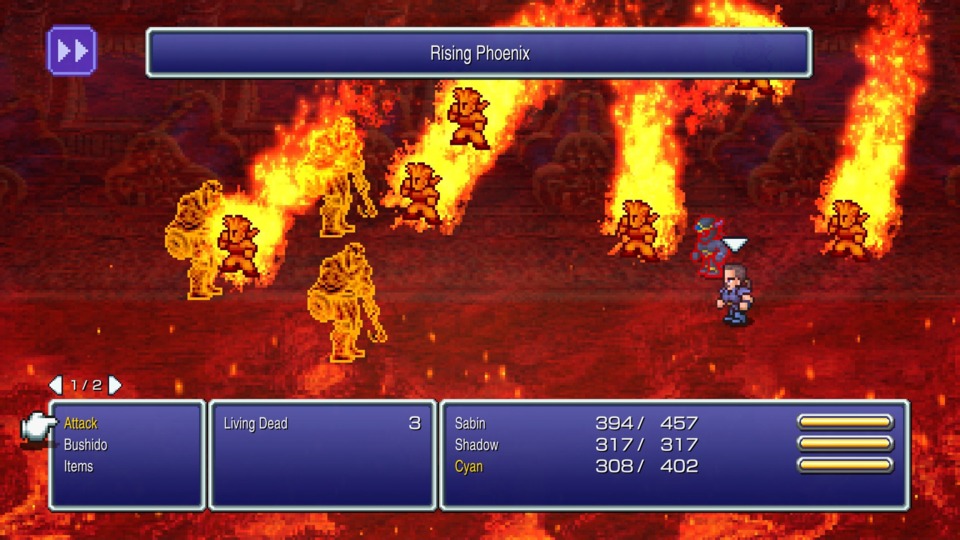
I ended the last episode of my written Let's Play series for Final Fantasy VI right before the start of Sabin's route following the battle against Ultros. While the game's introductory credit roll is an impressive tone-setting moment, your highly involved adventure with Sabin, Shadow, Cyan, and eventually Gau proves to be the first time all of its mechanics and characters click. It's far from the game's "best" sequence, but it is the first time I felt like it stopped its stunting act and realized it needed to be a JRPG with an epic storyline. Things start with Sabin washing ashore on a different continent and running into the elusive Shadow. During the last episode, I avoided discussing each character's specific mechanics; moving forward, I'll work to prevent that. Shadow is a weird character. His throwing mechanic is exciting but hard to rely on in the early game because his best items are costly. When you can stock up on his elemental scrolls, you are best off hot-swapping the best spell-casting Espers on to him instead. Along with Locke and Celes, he's one of the few characters that primarily rely on the regular "Attack" command, which means he's more reliant on Relics. As I mentioned in the previous entry, the characters that depend on the relic mechanic were among my least favorite because I found fiddling through the equipment menus annoying.
But in terms of making Sabin feel like a total badass, the first part of his route does precisely that. His Blitz command is one of the more involved specials in the game, and it is varied enough in what it does that I rarely had Sabin doing anything other than magic or blitzes. Likewise, Kefka starts to set himself apart during the siege of Doma Castle and the battles afterward. While exploring an Imperial Camp, Sabin and company overhear General Leo preparing the forces of the Empire for a prolonged siege as it is the "honorable" approach to defeating an enemy. While I would counter there's no honor in attacking and killing hundreds of people, including innocent civilians, he's a character rooted in Squaresoft's obsession with Bushido and modern samurai epics like Lone Wolf and Cub. When Kefka bucks those traditions, he does so in the most sadistic manner possible by poisoning the city's water supply. What often gets forgotten is how Kefka is one of many generals up to this point, and this act of genocide ends up setting him apart from the likes of Ultros and Leo. Before this moment, he's a clown who runs away after you land a single hit. However, with power in his control, we see what acts he's willing to commit to force the world to bend to his will. It is one of the few rare examples of a Final Fantasy game showcasing its villains during the opening moments and not losing sight of them.
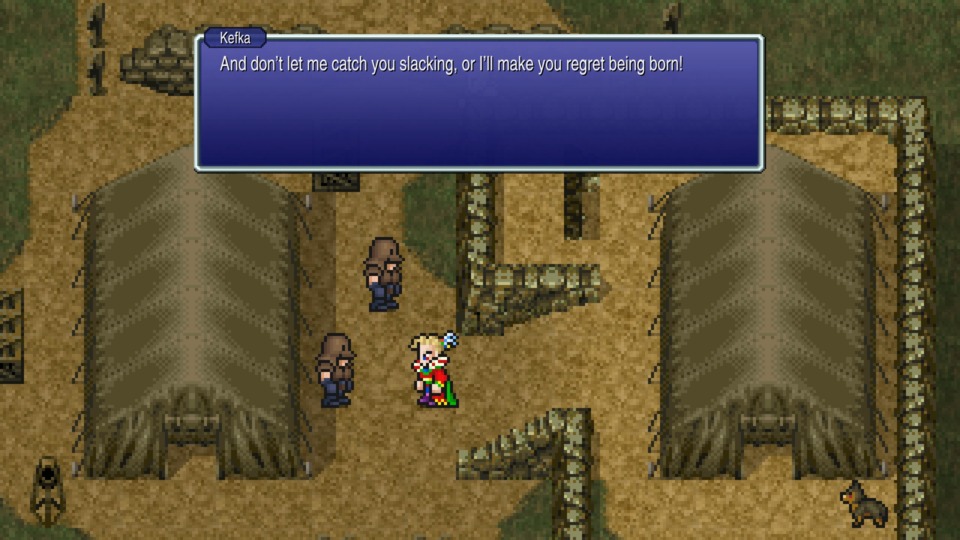
Then there's Cyan, the lonely samurai. I have nothing nice to say about Cyan as a party member. His Bushido ability is vanilla to a fault, and his main gimmick is that he hits hard and can wear heavy armor. It is discordant to have characters like Sabin and Gau, which have some strategy and complexity to their abilities, and then plop them next to Cyan, whose ability amounts to picking something in a menu and waiting for it to charge. I like to imagine that his out-of-date mannerisms mean that while he stands there charging up his sword techniques during battle, people are gazing at him, wondering what the fuck his deal might be. I don't think the game does enough to explain how Cyan and others rationalize using metal swords to fight mooks piloting mech suits, but that's a video game trope as old as time. HOWEVER, Cyan is the best-told character in all of Final Fantasy VI. Watching him become overcome with grief at watching the destruction of his homeland and family at the orders of Kefka is one of the game's darkest moments. That is something the game builds upon during the Phantom Forest when Cyan desperately attempts to chase after the ghosts of his wife and son as they depart into the afterlife. It's even a storyline they further expand upon and fully realize during his recruitment mission in the World of Ruin. Again, I hate using Cyan in my party, and if he were a bad overall character like Setzer, I'd be able to deal with that a lot better. But he's not, and that's a definite bummer.
Speaking of Cyan, let's talk about one of the most famous levels in Final Fantasy VI: the Phantom Forest. After ducking your way out of the Imperial Camp and going toe-to-toe with Kefka again, Sabin and company make their way to a mysterious forest populated by ghouls and specters. Eventually, the motley crew makes its way to a trainyard, and upon entering one of its cars, it comes to life and begins moving. The party realizes they are on a fabled train called the "Phantom Train," which takes recently-departed souls to the afterlife. During the pursuit off the train, there's a distinct sense of tension while the game allows everyone to strut their best stuff. Shadow's throwable scrolls hold their own, Sabin's fire dance is a godsend, and even Cyan has options to make things tolerable on the train. Then there's the Phantom Train boss encounter, which, as goofy as the internet always makes it seem, has a balance between the game's wackier sensibilities and its realistic sci-fi scaffolding. People sing effusive praise about the cheeky animations of watching your characters run away from the train as they fight it and Sabin's ability to suplex it. My version of the Pixel Remaster did not entirely "fix" Sabin's suplex, as you can see below. However, what gets less reported is how the Phantom Train is Cyan's level. Watching him drop to his knees as he watches his family leave him is one of the most gut-wrenching scenes in the entire game. It does so much to frame him as a man out of time and reminds you that everyone in the team, whether they show it or not, is in a different state of coming to terms with grief or loss.
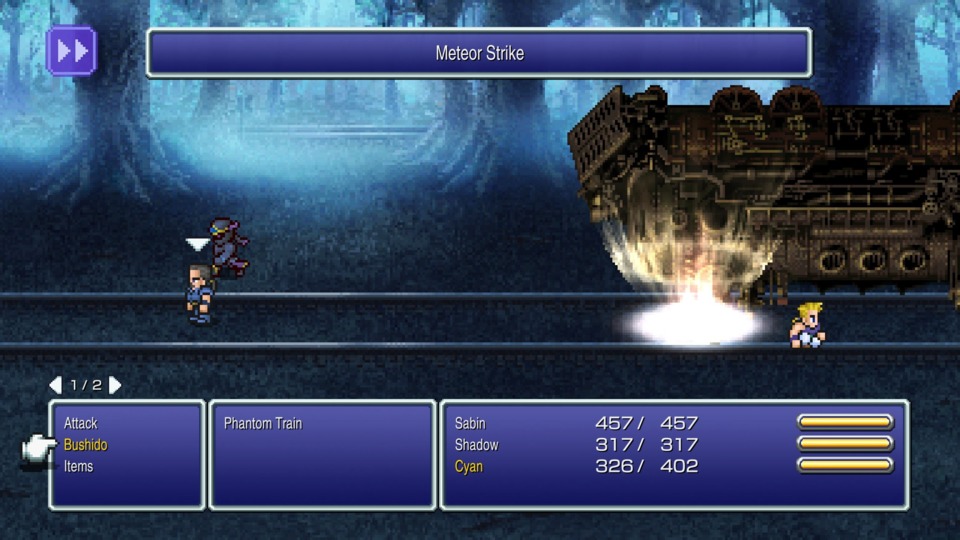
As impressive as Sabin's route might be, there are niggling nitpicks worth addressing. First, when the game presents the three paths, it does so with a sense that each is of equal importance when the opposite is true. If you pick Sabin's route first, you can end up fucking yourself because it involves multiple boss battles and far more challenging enemy encounters. Second, it's a real bummer if Shadow leaves your party before you reach the haunted forest. During my first playthrough, because there's a 1/16th chance he will bounce at the end of ANY BATTLE, he left after my second random encounter, and all I had for the entire Phantom Train sequence was Sabin, Cyan, and a ghost. It sucked! The final issue related to Sabin's route is a structural storytelling complaint. Between this route and the coin toss scene, there's a growing sense that Sabin has unresolved insecurities and baggage to address with Edgar, but nothing comes of it. From this point forward, Sabin as a character is done for all intents and purposes. His character mission during the World of Ruin is among the least satisfying, and the game conveys the rest of his character-building during optional and missable cutscenes. It's disappointing because you feel like the game and writing are moments away from raising him to be more than the "gentle giant" archetype.
Part 7: People Still Hate Zozo For A Reason
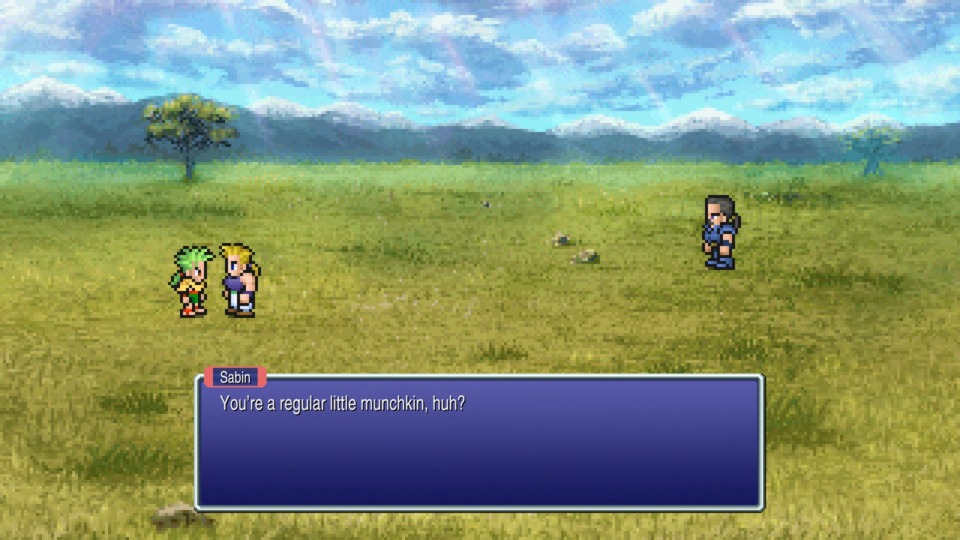
After surviving your ordeal on the Phantom Train and permitting Cyan some time to himself, Sabin and Cyan make the leap of faith from Baren Falls. Before that, there's an optional scene at a nearby inn wherein Cyan is taken aback by a waitress flirting with him. Sabin needs to assist him in understanding intimacy, and it is a reminder that these characters all have incredibly humanizing flaws or shortcomings. Cyan is far from being the only character who struggles to process the loss of a loved one, with Locke and Setzer looming on the horizon. Quick note, even in the Pixel Remaster, the game does not de-equip characters of their weapons, armor, items, or relics when they depart the game temporarily. I always forget that with Shadow, as I feel you can never predict when he's leaving and was down a Genji Glove until his return. Nonetheless, after washing ashore on the Veldt, Sabin and Cyan encounter a "wild boy" in the surrounding plains. When they enter the nearby town of Mobliz, they learn that using a piece of dried meat can convince the boy to listen to strangers. It's an odd quest and introduction to Gau, but considering how abnormal he is compared to the rest of your party, it somewhat prepares you for his mechanics.
Admittedly, I said my piece about Gau in the previous episode. Still, it bears repeating that it is bizarre that Final Fantasy VI has ostensibly TWO Blue Mages with Gau and Strago. Gau's approach to the Blue Mage archetype is more frustrating because he can only learn new abilities on the Veldt, which has its quirks and mechanics you need to consider as well. For one thing, none of the encounters at the Veldt bestow experience points, and at this juncture, where you still lack Espers, that's a consistent source of frustration. Now, I understand why the programmers designed the monsters at the Veldt not to provide EXP. Still, that results in many encounters translating into jack shit, especially if you end up running against repeat monsters or ones that don't have any Rage abilities to teach Gau. Also, there's no more frustrating feeling than queuing up a Rage only to discover that one or more of the enemies in front of you are immune to Gau's moves. In that case, you have a wasted character. However, there's no denying that the partnership between Sabin and Gau is one of the more pleasant ones in the game, and I wish there were more to it.
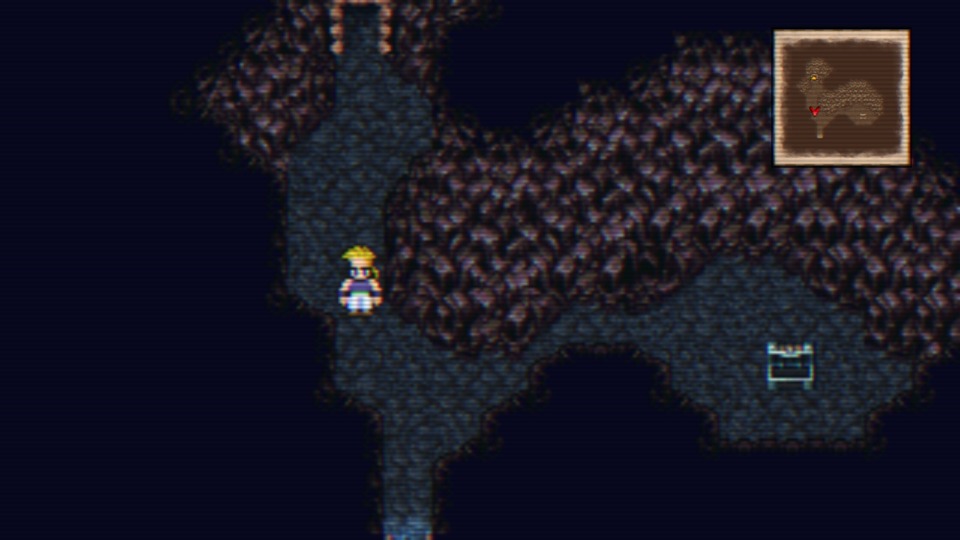
With Gau tagging along, you make your way to a cave where Gau provides a single diver's helmet. Using this helmet, between three characters, mind you, the party navigates a series of underwater currents called the "Serpent's Trench." Here, the game provides its most stark use of Mode 7. Again, I respect the game pushing the technical envelope. Nonetheless, I find the first-person sequences disorienting, and in the case of the Serpent's Trench, getting lost is almost effortless. The Serpent's Trench is a dungeon where you pick between left and right avenues from time to time in the first-person perspective, and if you are not playing it with a guide, you will likely take a less efficient path out of the trench. Speaking of short set pieces that are emotionally and physically exhausting, Final Fantasy VI does not let up when it ferries you to Nikeah and reunites everyone at Narshe to fend off an invasion led by Kefka. In a minigame that I can only imagine inspired the Fort Condor missions in the original Final Fantasy VII, you divvy up your characters between three pots (two groups of three and one group of two). Then, you plop each grouping at chokepoints leading up to the frozen Esper from the start of the game. The waves of soldiers you fight back feel endless, and it does a great job of further highlighting the power imbalance between the Empire and the rest of the world. It goes on longer than it should, but by the time it is over, the Returners feel like children eating at the kiddy table, and I think that's the intent.
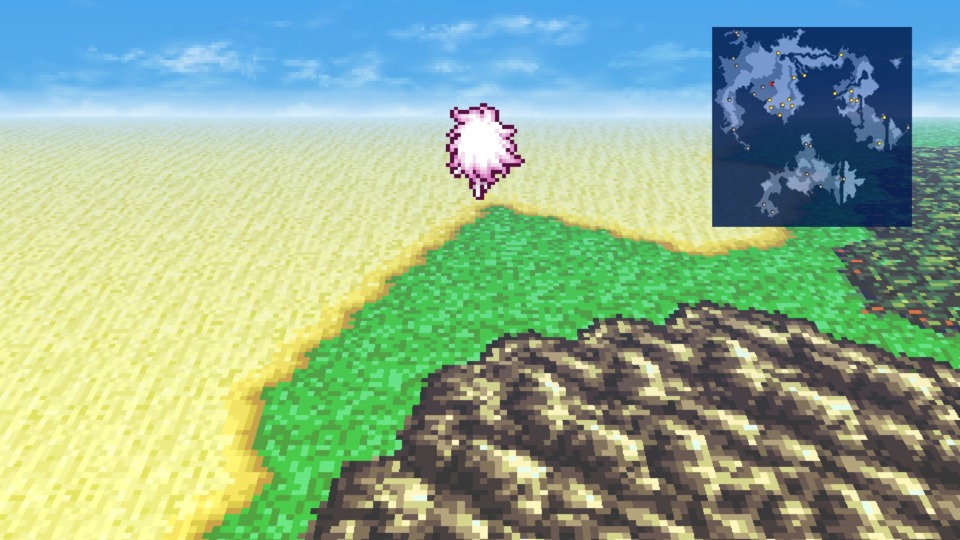
I am of two minds regarding everything you do between the Battle of Narshe and getting your first Esper. On the one hand, the worldbuilding involving Terra and the Espers is fantastic, and the use of flashbacks masterfully builds a growing sense of mystery that it fully delivers on by the time you wrap things up with Terra. Learning about her tragic upbringing and how she never had a childhood makes what the game does with her in the World of Ruin all the more perfect. On the other hand, Terra leaving the party sucks shit, and Zozo is one of the worst levels in the game. There are few levels in the game that Final Fantasy VI fans are united about in their hatred as much as Zozo besides the Cultists' Tower. The Floating Continent has its fair share of detractors, but I view the difficulty spike there as an understandable mid-game "gear check." Many others hate Kefka's Tower, but when viewed as the sixth entry in a franchise's tradition of wanting to kick your teeth in with final end-game dungeons, I view it as another "one of those." Zozo just completely sucks shit, but at least the characterization of Terra is masterfully done.
Likewise, the concept that Jidoor's aristocrats forced its lower-class citizens into a separate township that is riddled with crime, murder, and thievery is icky. Also frustrating is how you maximize the storytelling and worldbuilding during this sequence. Despite the game presenting your following party composition as a "player's choice," you'll miss out on some story-critical plot beats if you don't elect to use Edgar, Sabin, Locke, and Celes. The famous "coin toss scene" wherein Edgar absolves Sabin of his guilt for running away is secretly here. You can also miss the first hint of Locke's character arc if you fail to bring him along when visiting Kohlingen. Finally, the relationship between Celes and Locke starts here, but you wouldn't know if you didn't bring both along for the journey! It's a shitty design choice, but not nearly as shitty as the random encounter rate at Zozo. It's an outdoor dungeon, and that's interesting in concept, but it is a slog in execution. That random encounters do not stop when you enter buildings is beyond disheartening. The Hill Gigas encounter, wherein the enemy will pop off a massive damage-dealing move after its KO, is incredibly raw, considering how early it is in the game. But the level design drove me up the wall the most. The intricate pixel work to create a dilapidated metropolis was a headache to parse when the game was first released, and it is still a problem in the Pixel Remaster. The sequences where you hop between two skyscrapers sucked then, and it sucks now.
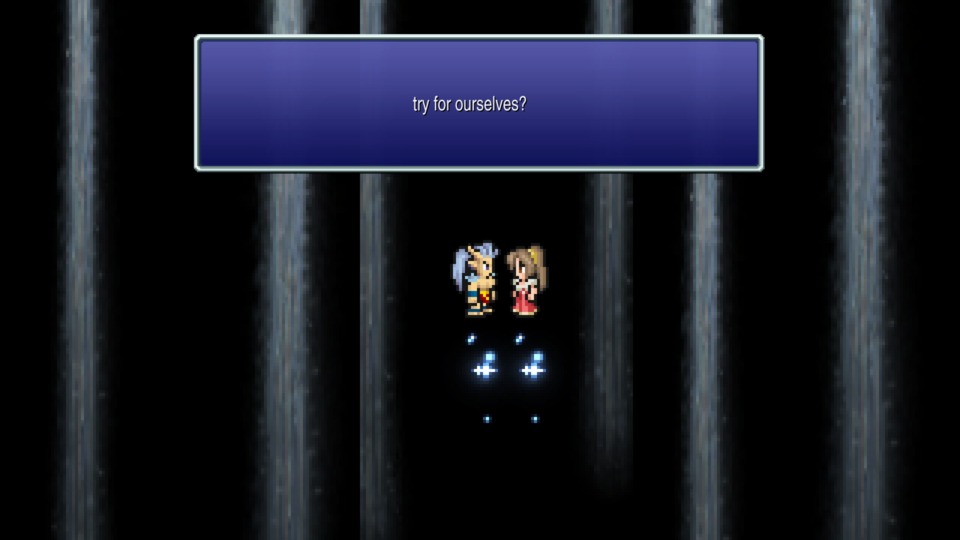
Part 8: The Magicite System's Weird Downstream Consequences
Let's return to Terra before I go on another gameplay-focused rant. When you reach the top of a skyscraper with Terra in it, your party runs up against the Esper Ramuh. This Esper provides a long lecture on the history of humanity's interactions with Espers and why both realms remain separate. Ramuh reveals that the Empire is conducting experiments on recently captured Espers in a research facility in their capital city of Vector and begs the Returners to rescue them. The plight of the Espers echoes a recurring theme that dots almost all of Final Fantasy VI: characters and people being in a stage of grief or loss. Each of the game's victims of grief reacts to it differently, and the game leaves it to the player to determine which reactions to death or failure are right or wrong. When you discover that Locke has a former lover of his in suspended animation as he seeks a cure, it's up to you to decide if his reaction impugns the wishes or rights of his partner. The only time the game passes hard or fast judgments about a character's coping process is when Setzer turns to substance abuse, but that's it. Stargo wanting to create a sheltered life for Relm? It's up to you to determine if he's in the right. Sabin letting his familial ties go dormant for years? You make the call. I sound like a broken record at this point, but it is refreshing to see a Final Fantasy game trust its audience to reach their own conclusions rather than feeling the need to spell everything out in ten to fifteen-minute diatribes.
I should also mention that I took the time to get Edgar's Chainsaw. The puzzle itself is a pain, but what is worth remarking upon is Edgar's utility to the party. Through his tools, before you unlock some of the more potent magical abilities, he's one of your more reliable crowd control options in the game. What's more, most of his abilities inflict significant status effects or debuffs that the early to mid-game encounters are not immune to or cannot block. Unfortunately, only a few of these tools scale well into the World of Ruin, and the progression system of gaining new tools sucks. Having to peruse a random open-air dungeon while meddling with clocks, so one of my party members can have their ultimate ability? FUCK THAT!On a similar boat is Locke. Final Fantasy VI tucking away some of the best items and weapons on bosses that need to be stolen is a continuation of a franchise tradition I hate with a fiery passion. Part of that stems from how long it takes to make Locke hold his own in combat. Because he's the only character that can steal, you almost need to have him in your rotation. However, as is the case with every thief in the eight to sixteen-bit eras of Final Fantasy games, the success rate on his steal command is awful, and it takes FUCKING FOREVER to make him useful during battles.
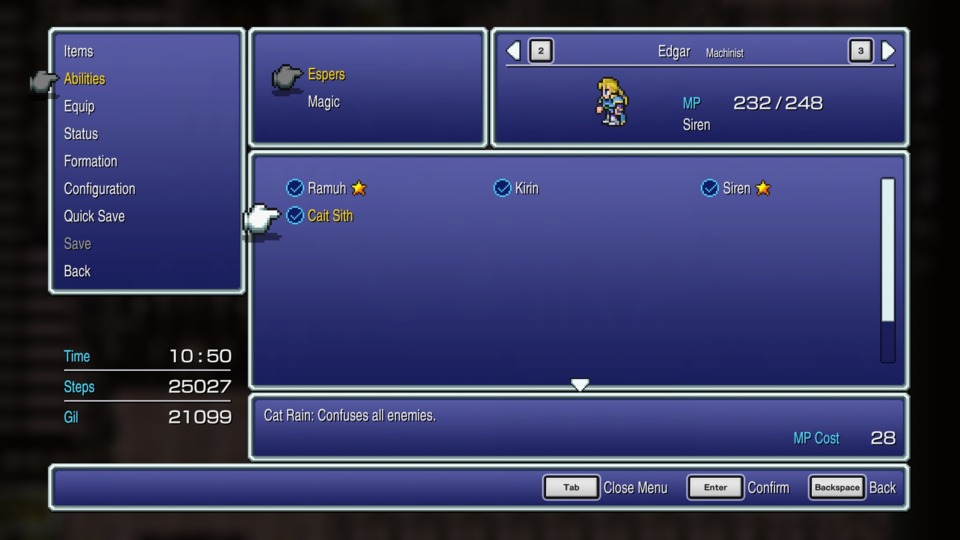
However, we are dancing around my central topic and thesis for this sub-chapter. After Ramuh sends your team to rescue his friends, both he and a smattering of Espers turn into stones (i.e., Magicite) that can then teach any number of magical abilities to your characters. I wouldn't go so far as to call the Magicite System a "leveling mechanic" like the Sphere Grid in Final Fantasy X. It's more on par with character customization features like Final Fantasy V's jobs or Final Fantasy VIII's Junction Mechanic. Your characters level up and gain bigger pools of magic points and health points as they did before earning the Espers. However, what has changed is that all enemies now provide "Ability Points" that allow characters to learn new magic commands at varying intervals depending on the Esper. However, the utility of Espers ranges a wide gamut. Some Espers teach new magical abilities, whereas others exist primarily to bestow buffs or stat boosts upon leveling up a character. To the mechanic's credit, the possibilities are endless. And yet, there are plenty of reasons not to like what the Espers add to the game.
To argue in defense of the Magicite mechanic, while you can take the time to teach every character every ability under the sun, I don't suspect that was the intent of the original design team. I think they provided the Espers and their sometimes overlapping thematics to allow players to "cover all their bases." Suppose you find yourself in an environment lacking the specific elemental spells that make it demonstrably easier. In that case, you can hot-swap whoever is in your party to make them capable of being successful in their present environment. Is your only healer low on MP, and you don't have an alternate? It's miraculously easy to teach any character the most basic Cure or Cura command as both are held by at least four or five Espers. A considerable amount of work was put into the system to allow it to make life easier in Final Fantasy VI. At no point was I ever afflicted with a sense of anxiety in my choices of Espers like I was when experimenting with similar systems like the Sphere Grid in Final Fantasy X or Final Fantasy XII's License Grids. But in the case of Final Fantasy VI, consider this case study. Let's say you take the time to level up Cyan, and he becomes an absolute workhorse in your party rotation. Whatever you did or discovered is not novel to Cyan; you can apply that same strategy to every party member, and you will get the same results. Yes, it is satisfying, but there's no denying that the game's initial act of presenting every playable character as unique or distinct from one another is a bit of a sham.
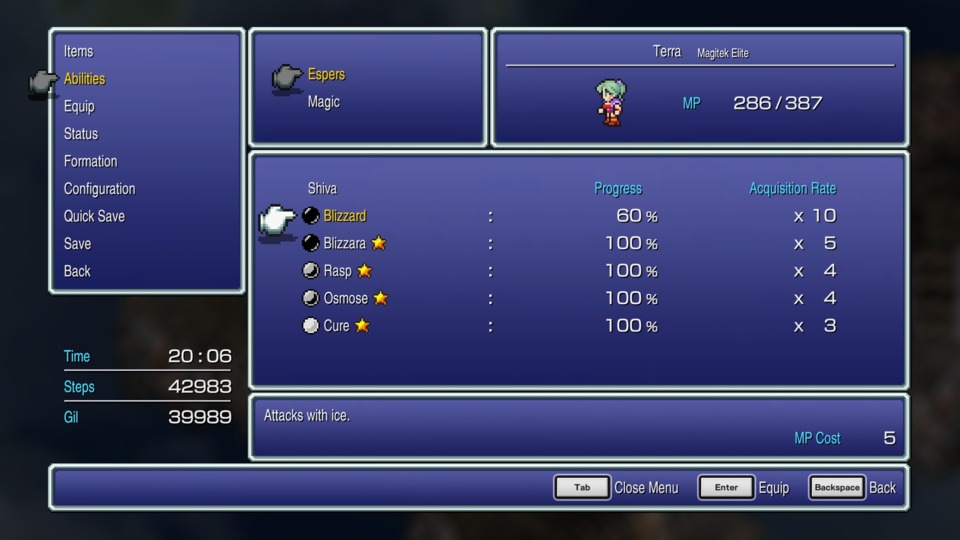
There's no denying two significant complaints with the Magicite system. The first is the time commitment it requires. If you enjoy grinding in RPGs because watching numbers go up or menus fill out with new abilities gives you a rush, this system is right up your alley. Nonetheless, this process often takes hours and what the Magicite mechanic's defenders often overlook is how painful it is to keep all of your lesser-used party members on par with your favored ones. Because the World of Ruin essentially requires teams of characters working together in groups, you must divide your attention across virtually all of your characters unless you want to be caught with your pants down. Sequences that require specific characters can get gnarly if you are not careful in the World of Balance. Worse, when you combine the Espers with the Relic System, I spent on average at least seven to ten minutes fiddling around in menus whenever I swapped from one group of characters to another. Again, there's a give and take here. When you take the time to explore exciting ways the Epsers and Relics can complement each other, you can create unspoken sub-classes in the game, and I found that highly rewarding.
However, the most significant issue with the Espers presents a real quibble some, including myself, have with Final Fantasy VI. Over time, Final Fantasy VI's character-specific abilities fall to the wayside in favor of its magic system, which denies them any unique characteristics in combat. Once you get the Espers, you end up making the same two to three character archetypes over and over again. Three to four characters specialized in healing magic, three to four specialized in buffs and debuffs, and three to four specialized in elemental or non-elemental offensive spells. Despite the game's early signposting of what each character might be inclined to be better at, it doesn't matter in the grand scheme of things. Much like the modern Fire Emblem games, anyone and EVERYONE under your disposal can become a tool of destruction if you put the time into it. When the game starts providing massive AP-dropping enemies, even those roles begin to blur as every character goes from being a specialized fiddler crab to venerable murder machines AND party-wide healers. If you consult any guide or walkthrough for Final Fantasy VI, you'll notice there are at most three end-goals for every character. One of these, Ultima Spam, is so broken that it has become an in-joke among all Final Fantasy VI fans. That said, I'm not going to sit here and lie to you that I didn't have fun playing around with Espers. I spent hours upon hours making sure everyone in my playthrough was at least level twenty-five and had a blast doing so. Here, we have a classic example of a "difference in opinion." If someone tells me they think Final Fantasy VI is the last time the summons in a Final Fantasy game felt entirely justified, I understand them. However, if someone says the Espers are just "the same shit over and over again," I also get them.
Part 9: The Opera House Scene Is Still AMAZING (But Setzer Sucks)
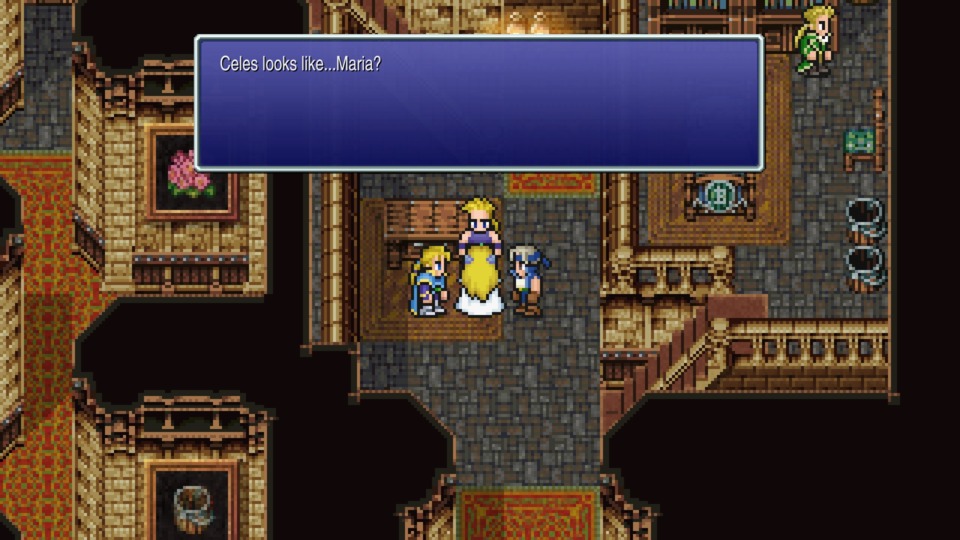
After finishing your talk with Ramuh, your team will make its way back to Jidoor and run into the Impresario, who runs a nearby opera house. He will remark that his latest production is in trouble because a pirate king wants to kidnap his leading actress (i.e., Maria) and that Celes looks oddly similar to this actress. Locke will surmise that this problem can be rectified if Celes impersonates Maria during the upcoming stage production and the Impresario agrees. What takes place next is Final Fantasy VI's famous "Opera House scene." I hate to disappoint you if you expect me to be a contrarian asshole about the single most beloved moment in the franchise's history. This entire scene is a fantastic set piece that uses every technological trick up its sleeve to make one of the most cinematic moments in video games. Which is astounding when you consider each part of it sounds blasé or boring on paper. Needing to memorize lines from a play for in-game quick-time events? That sounds painful! A play within a play as the focal point of a set piece? That's not exactly a new idea. And yet, it works.
First, let's address "the elephant in the room." The Pixel Remaster's flaws are forgiven in light of its AMAZING work to make the Opera House scene look gorgeous. The shadows, lightning, and spoken lyrics create a more cinematic and engaging setting. The use of the Octopath Traveler engine is undeniable. Still, the Pixel Remaster design team has tamed its light bloom effect so that the moodier and more emotional moments at the Opera House are not camouflaged for high-resolution pixel work. Speaking of the pixel work, it's simply amazing. The castle during the Opera House has a more believable 3D effect, and the animations of the characters are easier to discern and interpret. Small finger waves, leaps, and character poses are just as much fun as they were the first time, but here they feel more charming as you get a better sense of the implied emotions of the characters. Some prefer the SNES version's synthesized bleeps and bloops to the use of real lyrics, but I'm the opposite. I find the SNES sound chip grating and downright awful at times, and the Pixel Remaster to be the vastly superior alternative.
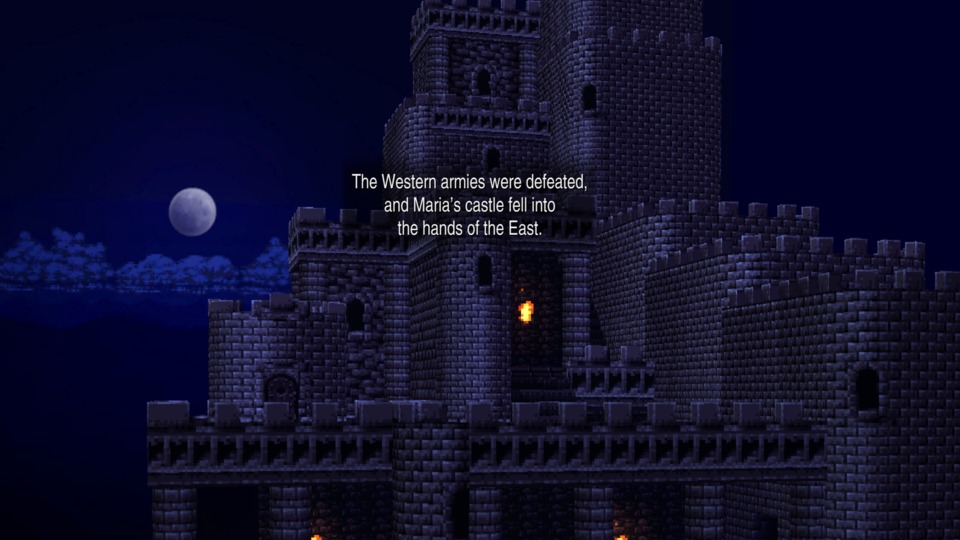
I have seen a handful of people mention dislike towards the transition to Ultros' wacky scheme, but I am not one of them. Final Fantasy IV, V, and VI are the games that most feel like they are paying homage to East Asian fables, classics, and Peking or Kabuki opera. When you view the battle against Ultros as the climax of a play, it makes thematic sense. Characters jump into the scene, bow, and billow their introductions as they would in a Jīngjù production. And when you accept that the Opera House is equal parts Squaresoft stunting and throwing the player some breathing room after all of the heavy shit involving Terra and the genocide of the Espers, I'll take some wacky hijinx; thank you very much! There's also something quaint and charming about watching an Italian Opera director needing to "wing it" when the battle with Ultros commences. Furthermore, the way the game "sticks the landing" is something that needs to be seen instead of viewed on a blog.
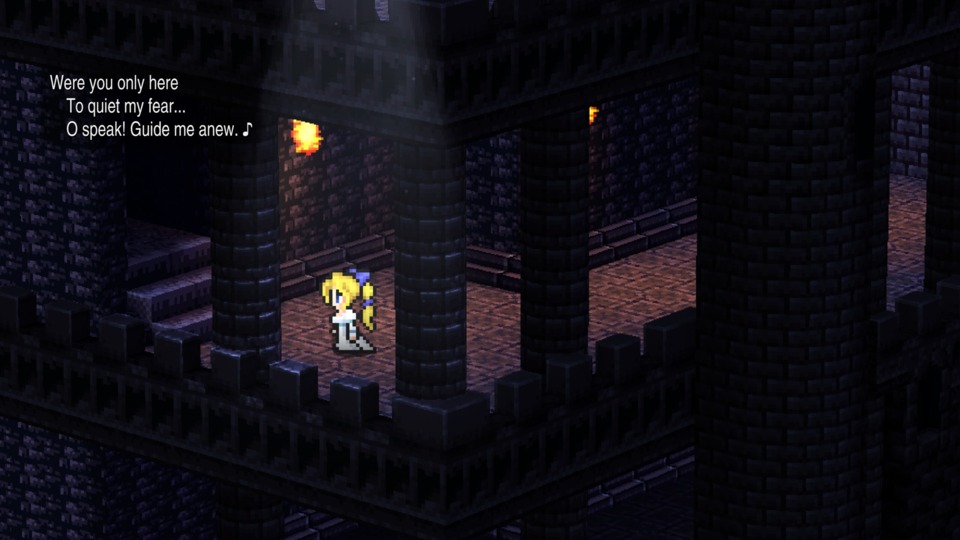
The Opera House scene is forever good. The original version of the scene is even more impressive when you consider it was accomplished in the late 1980s. Unfortunately, Setzer sucks. I have said it before, but I will repeat it for posterity. I hate how there are TWO "Casanova Wannabe" archetypes in Final Fantasy VI. Setzer's sexually harassing and womanizing antics feel redundant when you already have Edgar. Likewise, the very premise of this scene is that he wants to kidnap a female character and bend them to his will. Please stop and think about how horrible it is in the real world to experience or be a victim of kidnapping, and I think you realize Square's reliance on it as a writing crutch, EVEN TO THIS DAY, is all the more reprehensible. I get that some might be able to say, "It was a different time," and then move on, but I can't. I especially cannot give the game the benefit of the doubt when every central female character becomes a damsel in distress and a victim of kidnapping or imprisonment at least once in the story. Squaresoft was at the time a "boy's club," and that reeks here, and if ever there was a sign that even in their "glory days," they needed to be more culturally and socially conscious of other genders, races, or creeds, this and Zozo prove the case.
Whenever I have expressed these concerns while praising the Opera House scene, I end up with the same arguments in defense of its unsavory underpinning. I don't know how many times I have heard people point toward Celes getting the better of Setzer by using a weighted coin to force him to join the party, but that doesn't excuse the story's reliance on kidnapping women as a cheap plot crux. Also, let's be honest for a minute. Who are these people that enjoy using or playing Setzer?I hate his slot machine mechanic even if I find it one of the more visually pleasing character-specific commands. Due to it being a slot machine, you can never rely on it, and I don't care what weirdos on the internet claim to be the "tricks" on how to guarantee you always summon Bahamut when using Slot. I tried all of them and still ended up with Mysidian Rabbit more than I'd like. And that's still ignoring the fact that there's a chance he murders your party! Things only marginally improve if you decide to swap Slot out for Gil Toss, but I was never down to sacrifice my Gil when there were plenty of items, armor, and weapons to buy until the final chapters. Setzer also has one of the worst plot arcs in the game, and the fact he's one of the required characters you recruit in the World of Ruin is a massive drag.
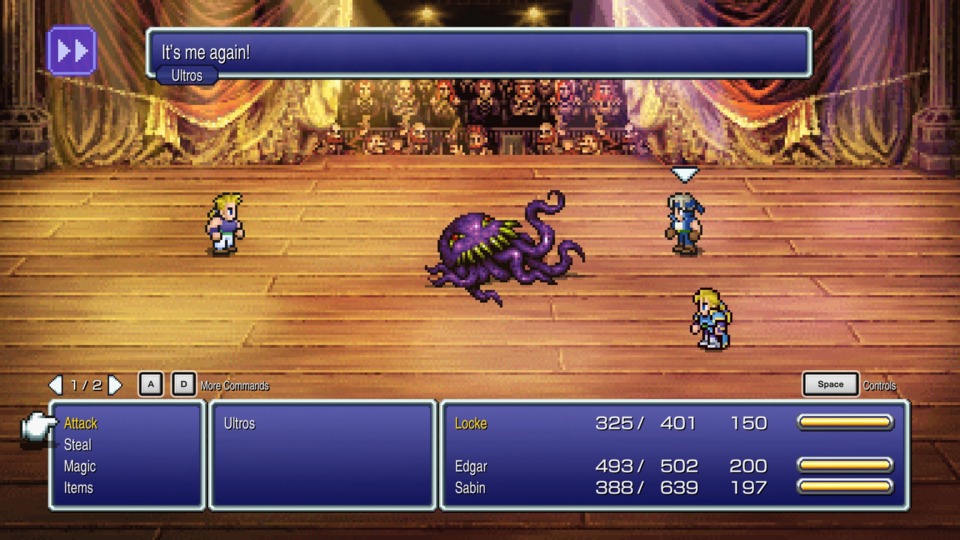
Part 10: Right, Terra Is "TECHNICALLY" The Game's Protagonist
With an airship finally at your disposal, your troupe of charming rogues parks at Vector's outskirts before entering. Vector is a teeming technologically advanced metropolis far grander than any of the villages you have encountered. You can also explore nearby towns off the beaten path using the airship. I completed the side quest at Maranda involving the injured soldier and tied up a few other errands at the surrounding towns of Tzen and Albrook. If you take the time to interact with any of the NPCs in these cities, you will discover they are presently under occupation and clue you into life in the Empire. When you do make your way to Vector, you encounter an undercover agent for the Returners who provides a distraction for your party to enter the Magitek Research Facility. Before I sing praises of what the game does in terms of its narrative, there's no denying this is one of the more demanding levels in the World of Balance. I had a hard time correctly interpreting where platforms began and ended. Similarly, the conveyor belts are endlessly frustrating. The good news is that the level uses treasure chests as a breadcrumb trail to where you should go, but getting lost is incredibly easy.
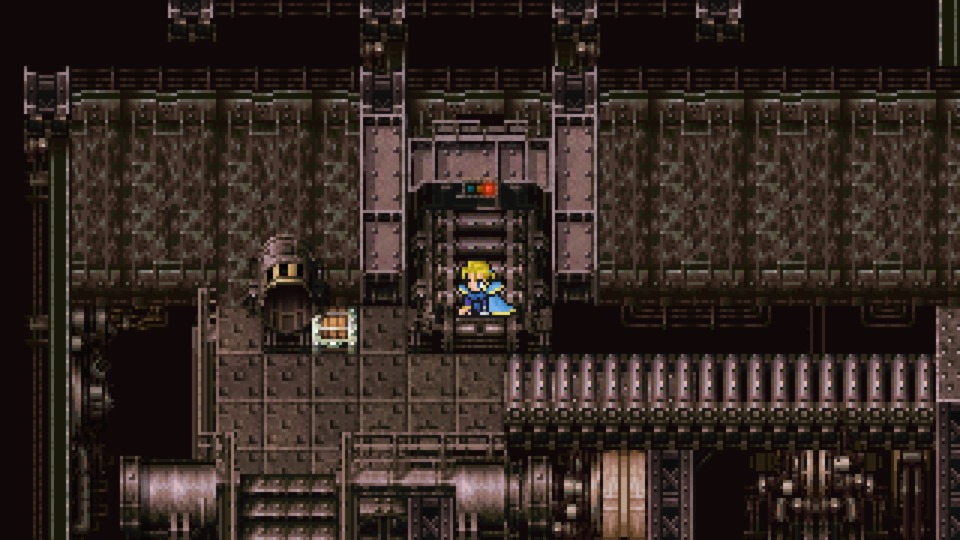
However, everything subsequently accomplished in the facility and the Sealed Gate makes up for whatever design quibbles I might have. It is odd to think, but Ultros has had as much air-time as Kefka up to this point, and the research facility highlights how they exist on different planes of villainy. Through several interactions with the Espers, you learn they are sentient beings that want to live as freely and happily as your party members. Thus, Kefka's comically cruel treatment of them is all the more tragic. After you battle Ifrit and Shiva, they paint, as well as the corpses in the background, an incredibly bleak picture of what Vector's scientific research does to Espers. However, they also make it blatantly clear that when Espers turn into Magicite, they sacrifice their lives to ensure that whoever holds them will honor their code of ethics. I always forget this detail, and it consistently catches me off guard. Nonetheless, it's another sign that things are desperate for the forces that wish to oppose the Empire, so much so that one side must rely on sentient creatures sacrificing their lives.
To complement the dower tone of the Research Facility, you eventually encounter Cid, Celes' adopted father. Cid is the architect of Vector's rise to prominence, but upon realizing the Espers are a conscious people, he disavows his work and declares that he will attempt to stop further research. However, when Kefka arrives, he immediately dismisses Cid, and because of villainous chicanery, the facility begins to self-destruct. Celes leaves the party with everyone doubting her allegiances, and as they attempt to depart using a train Cid summons, a monstrous artificial creature attacks them. It bears mentioning that the final portion of the research facility is an early-game boss rush. Things start with a fight against Number 024 and then climax in a Mode 7 battle against Number 128, the latter of which is significantly more challenging. However, you must also deal with the Crane boss encounter before you can catch your breath. In terms of action-oriented set-pieces, this entire sequence is one of the best in the game. There's a genuine sense of needing to fight back an endless onslaught of enemy forces, and the visual variety of backdrops is an absolute delight. The 3D work leading up to the Number 128 boss battle is the best example of the game operating on a then-unheard-of level of technical excellence.
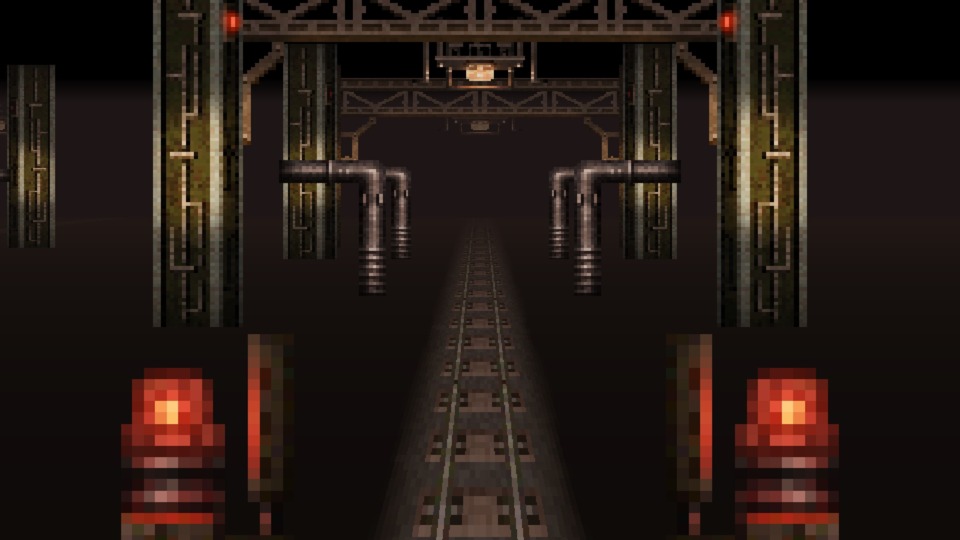
However, Vector and the journey to the Sealed Gate are all in the name of bringing Terra to the forefront. For the most part, the game is successful in this endeavor. I cannot deny that I felt something when I first watched the flashback where you control Maduin. Watching Maduin fall in love and take steps to be a family man, only for all of that to evaporate because of a selfish emperor's pursuits, feels timeless and apt. Again, few games in the Final Fantasy franchise today bother to humanize their summons, let alone make them the focal point of their stories. Today, most modern, post-FFX titles view them as nothing more than a source to provide flashy animations or visual flair. So, when Terra learns about her past and how her childhood was ripped away from her, I think everyone sympathizes with her rage. When she frees the Espers from their realm, and they begin to rain destruction on the human world, I think you relate with them more than your party. However, up to this point, you still feel like there's hope for both sides to settle their differences and live in peaceful co-existence. Therefore, when Kefka rips that away, it is a decisive moment that underscores him as the story's ultimate evil and reiterates the game's central theme of overcoming failure. Some people forget that unlocking the Sealed Gate leads to a spectacular example of an anti-climax "done right." The Returners open the gate expecting the Espers to assist them in fighting back the monolithic Empire. Instead, they blame the totality of humanity for the death of their friends and wage war on everyone.
I don't think people give Final Fantasy VI enough credit for realizing that sometimes levels in an RPG are meant to be vessels for storytelling rather than playgrounds for battle tactics. I cannot remember a single random encounter or battle I had in the cave leading up to the Sealed Gate, but I recall entire plot threads from the cinematics before and after you reach it. The use of combat screens when the larger Espers rush out of the Sealed Gate is among my favorite use of the feature. The Esper pixel work was impressive even in the SNES release, but in the Pixel Remaster, they are even better, with fluid and highly detailed animations to boot. Between the non-player battles between Kefka and the Espers and the first-person Mode 7 sequence in the research facility, Final Fantasy VI flexes while its ultimate "plot twist" looms in the future. I forgot to mention it, but when you first pilot the airship, there's a brief scene as you watch the city of Vector rise on the horizon. Scenes like that show how much Final Fantasy VI went on to inform Final Fantasy VII's directorial and aesthetical choices. The Returners, awkwardly milling around in the ruins of Vector, knowing they are at least partially responsible for the havoc, CLEARLY went on to inform Squaresoft how they wanted to frame Shinra and Avalanche during Final Fantasy VII's opening hours. It speaks VOLUMES of Final Fantasy VI's legacy and its timeliness qualities that people were more than happy to allow Square to try its ideas a second time, but with a different veneer. And on that note, I'll close this blog. Next time, we'll go from the Sealed Gate to "THE BIG TWIST" and dabble in some side quest nonsense.
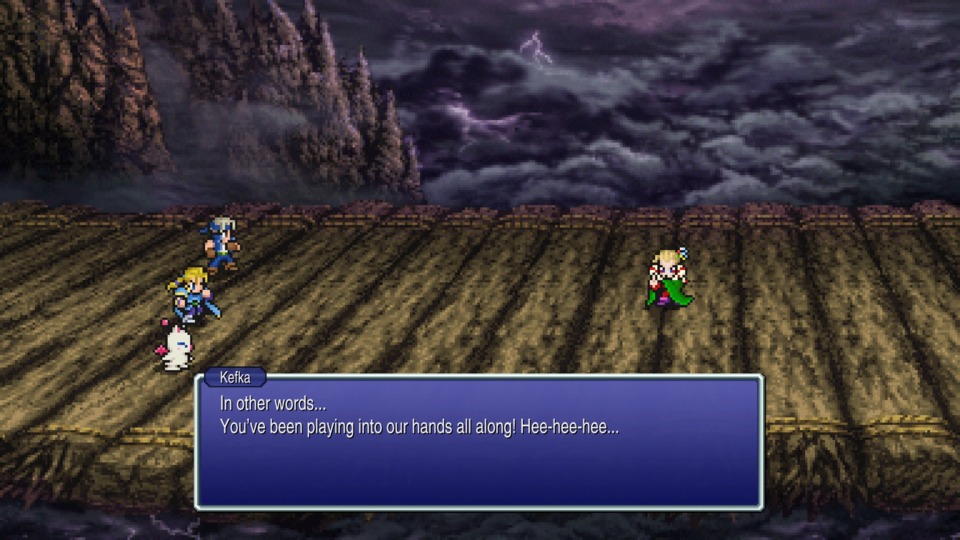
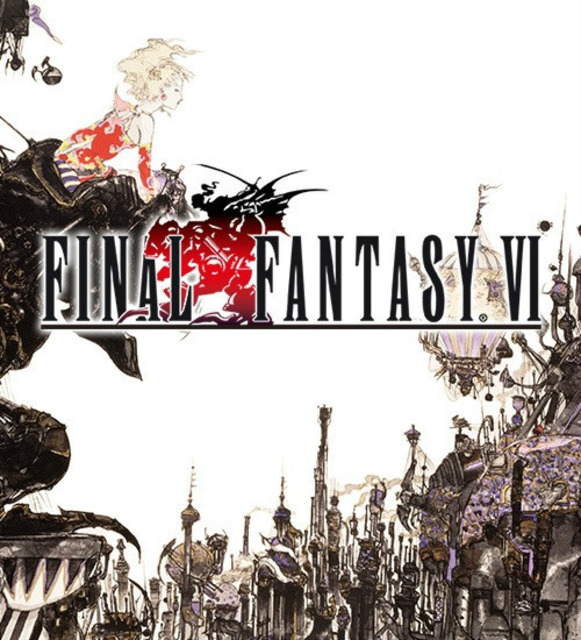
Log in to comment